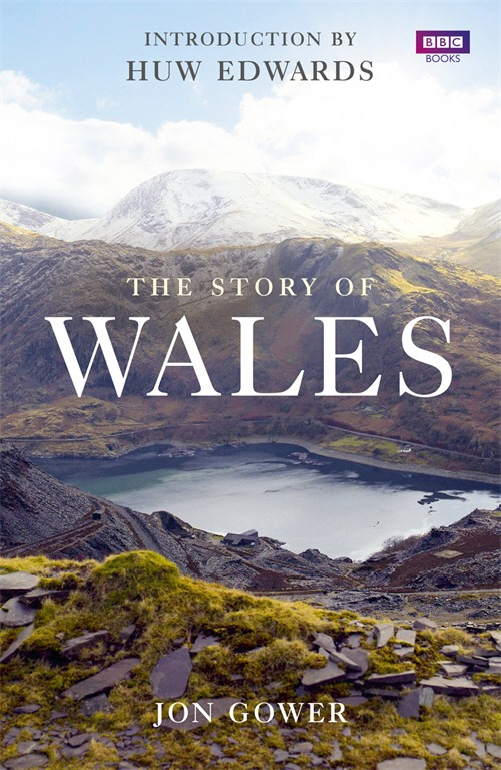Adam Somerset looks at the benefits and limitations of an expansive title when he considers Jon Gower’s latest tome, The Story of Wales.
A writer, concealed beneath the soubriquet of ‘cymro ken’, has awarded this book a one star review on Amazon. It is a harsh judgement that is made on two grounds. The book is lacking in comprehensive scale and contains a number of cited errors. This is, however, a judgement that fails to take into consideration the genre. As such cymro ken undervalues the book. It is a television spin-off and should be judged within the context of that genre.
The television series has already received a full and critical essay on this site. That essay reported on the criticism heaped on it by historians, along with the accusation of “landscape porn” – the Assembly could do Welsh culture a useful service by legislating against any television producer ever again renting a helicopter to fly low-level over Wales. Dylan Moore’s view of the series was in some respects similar to cymro ken’s of the book: “This is a story of Wales not the story of Wales, but the titular phrase is repeated so often in every episode that we begin to feel needled by the narrative thread.”
However, the book is the book and not a television documentary. The BBC as publisher gives as much prominence on the cover to their staff member, respected as he is, as to the author who has actually done all the work. Huw Edwards gets an inside jacket photograph and a blurb fifty percent longer than that of Jon Gower. There is no mistaking the marketing pitch. The chapter structure has been pre-determined by the structure of the programme. However, given that the book belongs to a genre, Jon Gower has delivered a good, lucid piece of work aimed at the popular reader.

by Jon Gower
368 pp, BBC Books, £20
Cymro ken notes the absence of mention of the textile industries. It is quite true that Bala’s leggings and Llanidloes’ flannel go unrecorded. I passed through Llanidloes during the reading of the book. The serenity of the town’s Minerva quilt centre belies the violence of the Chartist uprising. “The Story of Wales” narrates the events of April 1839 as “people took to the streets…to express the depth of their feeling.” It was a bit more than that, but then the book’s scope and word count have been pre-determined by the commission.
Another Amazon reviewer refers to, and prefers, John Davies’ “History of Wales.” As a work of history Professor Davies’ work is going to have the sheer weight and authority of a professional academic that a writer of fiction and travel is never going to attain. But that is not to compare like with like and “The Story of Wales”, unlike some TV tie-ins, has a bibliography running to more than a hundred reference works.
This particular story of Wales is created for a different audience, one that is less likely to explore Professor Davies, Kenneth O Morgan or Gwyn Alf Williams. The view through a cultural lens is different. As example, the Eton-educated director of “The Proud Valley”, Gower tells us, originally wanted to call it “One in Five”, in reference to the injury rate in the mines at the time.
As an introduction the writing has crispness and flair. I personally have small interest in medievalism, where and when the borders of Sycharth or Deheubarth moved and shifted. But I am interested in the last couple of centuries. The legacy of dissent and revolt is at the centre of Wales’ cultural self-defining; forty-four distinct historical events are listed on bdaugherty.tripod.com/cymru. A recent National Theatre Wales production made direct connection between an impending Wikileaks prosecution and a tradition of the Newport Rising and the Rebecca Riots.
The latter happened all around my part of Wales: a former tollbooth is visible from the room in which I write. I began by seeing what Jon Gower had to say. He gives the subject a couple of pages; it is a full and good description.
The book has two virtues. The commission has been given to a writer who is incapable of composing a dull sentence. There is the odd colloquialism like “buy into the urban lifestyle” but then there are many compensating lines like “they would shark in from the open waters.” A woman in wartime Canton dawdles on her way to the air raid shelter. She cannot locate her teeth. “Hitler’s dropping bombs, not sandwiches” comments her neighbour.
Secondly, it is right up to date but avoids shrill patriotism. The author of the list of riots above, for instance, omits the anti-Jewish riots of 1911 and Cardiff’s racial violence of 1919. Jon Gower gives space to a meaty excerpt of a speech by Aneurin Bevan, excoriating the possible influence of government by a coven from the Fro. It is a piece of history now but it is good that the text does not evade these tensions. More street parties were held, he reports, in celebration of 2011’s royal wedding than in any English region outside London.
Cymro ken claims that Gower makes no mention of “the devastation caused to communities by the closure of coalmines, steel making.” In fact the section on the miners’ strike states “the region suffered hugely from deprivation and community breakdown. Some communities became ghost villages.”
The BBC has a tendency to be cavalier in its treatment in programme credits. It is the artists and performers who bring in the audiences. The corporation’s PR folk are given leave to shrink the credits, speed them up, talk over them. Llanidloes features in the text but not in the index. From first sight of the index it appears a curious history that includes Mrs Thatcher but has no Salesbury, Penderyn, Wilkinson, D A Thomas. In fact the text is full but the indexer has been remiss in her/ his job.
As a venture it looks as though it has been outsourced by BBC Wales. Outsourcing is always hazardous and requires the tightest quality control. As the author is a journalist and writer of decades’ experience, it may well be that the materials referred to have themselves been in error. Whatever, that is what publishers do, they check the facts, they ensure the quality of the index. The managers of BBC Wales are but temporary custodians of a great brand name. Words need to be spoken with their contractor.











